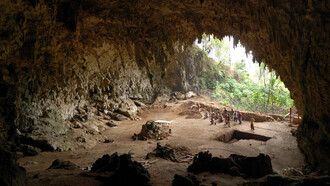The exhibition ‘Deposition’ by Jumana Manna at Serino Aqueduct — an archeological site located in Borgo Vergini, Rione Sanità (Naples) that holds the remains of an aqueduct from the Augustan age — is the fourth edition of the contemporary art program titled Underneath the Arches, directed by Chiara Pirozzi and Alessandra Troncone, in collaboration with the VerginiSanità Association. The project aims to re-value the artistic heritage of the archeological site through contemporary art installations.
In the first edition of Underneath the Arches, the Serino Aqueduct hosted the production of the Mexican artist Arturo Hernández Alcázar, who, starting from the cultural and geological stratifications of Naples, combined the multiple city’s sounds into a single track. In the second exhibition of Underneath the Arches, the Turkish artist Hera Büyüktaşçıyan invited the audience to a virtual water path, using an immersive installation, and investigated the element of water as a metaphor of fluidity and memory. During the thirst appointment, the Cuban artist Adrian Melis recreated the original flow of water by recruiting a workforce in the Vergini-Sanità area and using the Foley art techniques.
For the fourth edition of Underneath the Arches, the curators selected Jumana Manna, a Palestinian visual artist and filmmaker based in Berlin, who explores the concept of power, focusing on the body, land and materiality in relation to colonial legacies and histories of places. Questioning the traditional conservation practices in the fields of archeology and science, Manna reveals the unruly potential of ruins as an integral part of life and its regenerations.
Starting from the Middle Eastern countries’ practice of leaving bread pieces outside for unknown receivers, the artist created a series of small ceramic sculptures which mimic this act of care. The practice of offering uneaten food to a stranger rids the giver of the guilt of wasting food; at the same time, it reminds of ancient Mediterranean civilizations’ habit of making votive gifts to the gods, in the shape of clay loaves and buns, later found as grave goods. Some of these examples are on display at the National Archaeological Museum of Naples and other museums in the Campania region.
Using the sculptural language, the artist created a site specific installation at the Serino Aqueduct and aimed to develop a link between ancient and present-day practices of care, which seem temporally distant but still in use today in some Neapolitan neighborhoods, such as Rione Sanità where the exhibition is located.
The exhibition ‘Depositions’ has been preceded by the screening of the artist’s movie A Magical Substance Flows Into Me (2016), in collaboration with Morra Foundation, at Museo Hermann Nitsch.
In this film, Jumana Manna as the filmmaker goes back into the history of Dr. Robert Lachmann, a Jewish-German ethnomusicologist who emigrated to Palestine during the 1930s. While attempting to establish an archive and department of Oriental Music at the Hebrew University, Lachmann created a radio program for the Palestine Broadcasting Service called Oriental Music, where he invited members of local musicians to perform their vernacular music.
Following Lachmann’s footsteps and visiting Middle-Eastern communities (such as Kurdish, Moroccan and Yemenite Jews, Samaritans, members of urban and rural Palestinian communities, Bedouins and Coptic Christians), Manna traces a link between them and put into doubt the logic of segregation and colonial discourses, allowing for ideas of the representation of authenticity and heritage to emerge.















